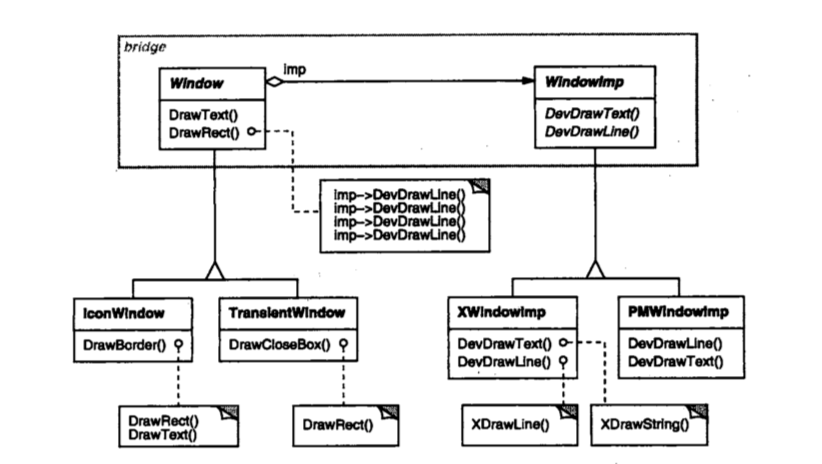将抽象和实现分离开来,使其分别可以独立变化。
在一个抽象可能有多个实现时,通常使用继承来协调他们。
这样在扩展Window抽象的时候十分不方便,比如需要增加一个IconWindow抽象时,要增加两个新类:XIconWindow和PMIconWindow
而使用桥接模式可以通过搭配来实现不同功能:将加法变为乘法。
桥接模式的结构
桥接模式的优点
- 接口和实现的分离:一个实现未必不变地绑定在一个接口上。
- 提高可扩充性,可以独立的对Abstraction和Implementor层次进行扩充。
- 实现细节对客户透明。
代码:
public abstract class TV {public abstract void on();public abstract void off();public abstract void turnChannel();}public class Sony extends TV{@Overridepublic void on() {System.out.println("sony.on()");}@Overridepublic void off() {System.out.println("sony.off()");}@Overridepublic void turnChannel() {System.out.println("sony.turnChannel()");}}public class RCA extends TV {@Overridepublic void on() {System.out.println("RCA.on()");}@Overridepublic void off() {System.out.println("RCA.off()");}@Overridepublic void turnChannel() {System.out.println("RCA.turnChannel()");}}public abstract class RemoteControl {protected TV tv;public RemoteControl(TV tv){this.tv = tv;}public abstract void on();public abstract void off();public abstract void turnChannel();}public class ConcreteRemoteControl extends RemoteControl {public ConcreteRemoteControl(TV tv) {super(tv);}@Overridepublic void on() {System.out.println("ConcreteRemoteControl.on()");tv.on();}@Overridepublic void off() {System.out.println("ConcreteRemoteControl.off()");tv.off();}@Overridepublic void turnChannel() {System.out.println("ConcreteRemoteControl.turnChannel()");tv.turnChannel();}}public class ConcreteRemoteControlplus extends RemoteControl {public ConcreteRemoteControlplus(TV tv) {super(tv);}@Overridepublic void on() {System.out.println("ConcreteRemoteControl.on()");tv.on();}@Overridepublic void off() {System.out.println("ConcreteRemoteControl.off()");tv.off();}@Overridepublic void turnChannel() {System.out.println("ConcreteRemoteControl.turnChannel()");tv.turnChannel();}public void turnOnThe4K(){System.out.println("turnOnThe4K");tv.on();}}public class Client {public static void main(String[] args) {ConcreteRemoteControl control1 = new ConcreteRemoteControl(new Sony());control1.on();control1.off();ConcreteRemoteControlplus control2 = new ConcreteRemoteControlplus(new RCA());control2.turnOnThe4K();control2.off();}}
运行结果:
ConcreteRemoteControl.on()sony.on()ConcreteRemoteControl.off()sony.off()turnOnThe4KRCA.on()ConcreteRemoteControl.off()RCA.off()


